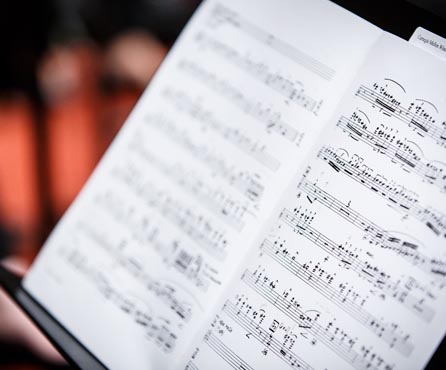
SOUNDCHECK - MUSIC RECORDING STUDIO A HIT
By: Bruce Gerson, bg02@andrew.cmu.edu
The School of Music is known for producing outstanding musicians, vocalists and composers, but it's also becoming recognized for its hidden jewel in the basement of the College of Fine Arts building.
That treasure is the popular Johnny Costa (A'51,'52) Jazz Studio and its adjacent control room, where students learn the technical craft of recording and where local groups are flocking to produce their work. The jazz studio, made possible by the McFeely Rogers Foundation, is named in memory of Costa, the late jazz pianist best known for his work as musical director of the children's television program "Mr. Rogers Neighborhood."
Riccardo Schulz, associate teaching professor in the School of Music, manages the studio, which also serves as his classroom. One of his courses, a seven-week, nine-unit mini-course titled "Multitrack Recording," is making a name for the acoustical laboratory by connecting with local artists.
This semester Schulz' 23 students include engineering, computer science, business, mathematical sciences, chemistry, humanities and, of course, music majors. They work in small groups to run recording sessions for visiting artists.
This semester his students have worked with musicians, including CMU students and recent graduates, performing various genres, from contemporary gospel, contemporary classical and folk, to jazz, rock, hip hop - including Cuban and Korean - and combinations, or fusions, thereof. They also run recording sessions for high school hip hop artists in CMU's Arts Greenhouse program.
"The students are responsible for communicating with the artists to get all the details. They set up the microphones, work the control board and run the sessions. This is a class in which the students do all the work and I sit back," Schulz said.
"I've found that if they have more of a stake in the process they learn more. The less I do, the more they learn.
Communication skills also are important, and I do remind them to remember the manners their parents taught them when dealing with the artists," he added.
Andrew Mort, a sophomore electrical and computer engineering major, appreciates Schulz' approach.
"This is something that is very useful because we really have to know our stuff in order for the session to go smoothly," Mort said. "The best way to learn is by doing and when Riccardo allows us to do it without him, we are forced to remember and perform the tasks by ourselves. This really helps me to learn in a quick and effective way."
Two of Schultz' former students - Fritz Myers and Eric Boulanger - have made recording music their careers. Boulanger (E'07), a violinist and chief engineer for The Mastering Lab in Oaji, Calif., works with Grammy Award-winning artists, producers and engineers on a daily basis. Myers (A'04), who served as a teaching assistant under Schulz, is a composer, musician and owner of Platitude Music, a production company in Brooklyn, N.Y.
Myers, who earned his bachelor's degree in music composition, said the experience in the CMU studio was invaluable and greatly influenced his career. He said as a student he learned that the recording studio played a powerful role in the finished product. He also realized there were more jobs in the recording industry than in composing.
"Riccardo was extremely supportive and really interested in letting the students use the studio in creative ways. He was very reachable and patient - exactly the type of person you want in a creative environment," Myers said. The studio's growing list of musical clients includes Tim Ruff (A'10), a staff member for CMU's Temporary Employment Services, and the popular Billy Price Band, an R&B and soul ensemble led by Billy Price, a.k.a. William Pollak, a marketing manager at the Software Engineering Institute.
Ruff, who describes himself as a "sophisticated pop" musician, is a singer-songwriter who is planning to release a full-length album this spring. He said the studio has a "great suite of microphones and different spaces to record." He said he played acoustic guitar in one room, piano in another and saxophone in the classroom area.
Price said the band captured tracks for 13 songs in the recording studio for its new CD that will be released June 4 on DixieFrog Records, a French blues label. The sound tracks recorded at CMU were then taken to a Fox Chapel studio for "mixing and tweaking." Price, who's produced more than a dozen CDs, said recording in the Costa Studio was Eric DeFade's idea. DeFade, artist lecturer in jazz and director of the Jazz Ensemble in the School of Music, is the Billy Price Band's saxophone player.
"He suggested it. We tried and it's worked out well. We're getting a lot of good sound. It's been a great arrangement. It gives students the opportunity to experience what a real recording session is like," Price said. Schulz said it was interesting watching the process in which the band recorded. "They lay down tracks. First it was the quartet - drums, keyboards, guitar and bass - with Billy singing by the soundboard. Second were the horn players, then Billy singing in the 'iso-booth,' and then the background singers," Schulz explained. Schulz called Price "energetic and demanding."
"He wants everything to be perfect, which is fine with me. That's what we're all about, too," Schulz said.
Billy Price, a.k.a. William Pollak, a marketing manager at the Software Engineering Institute, records in the Johnny Costa (A'51,'52) Jazz Studio. Photo courtesy of David Aschkenas
Reprinted with permission
Originally from the March 2013 edition of The Piper
http://www.cmu.edu/piper/stories/2013/march/soundcheck.html